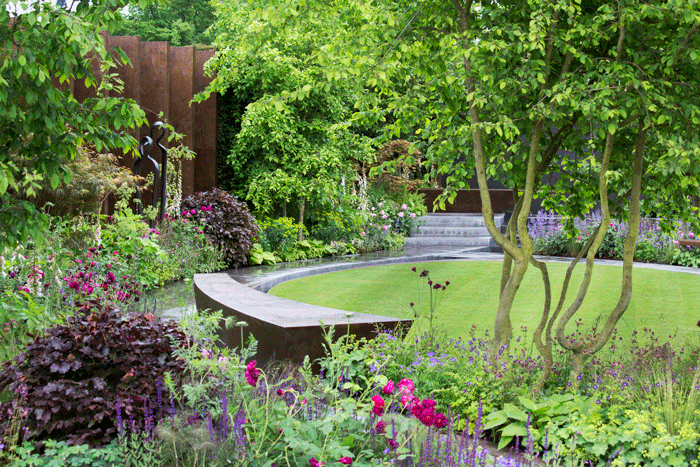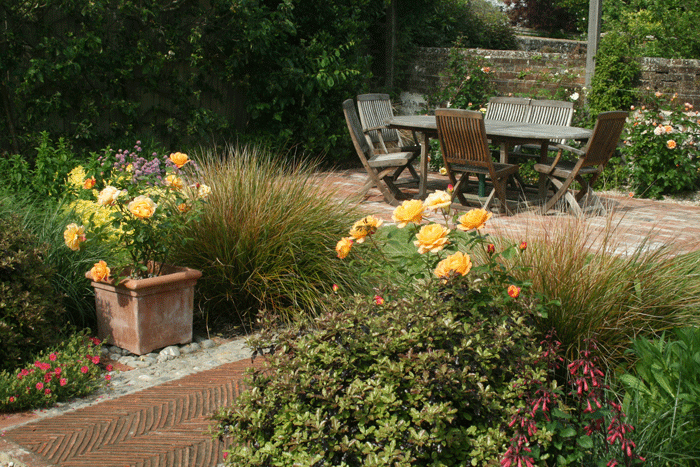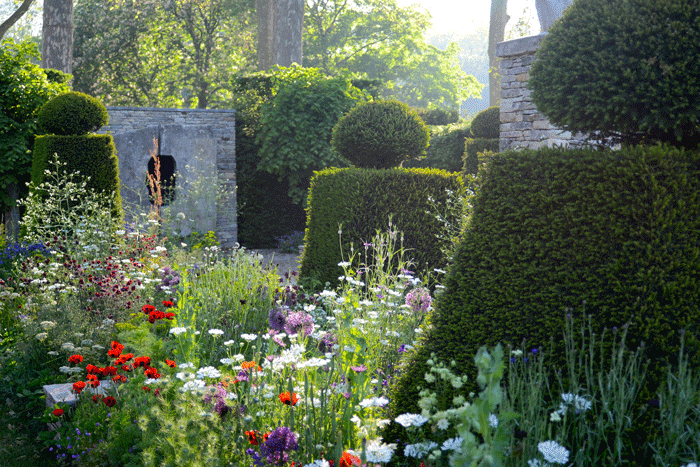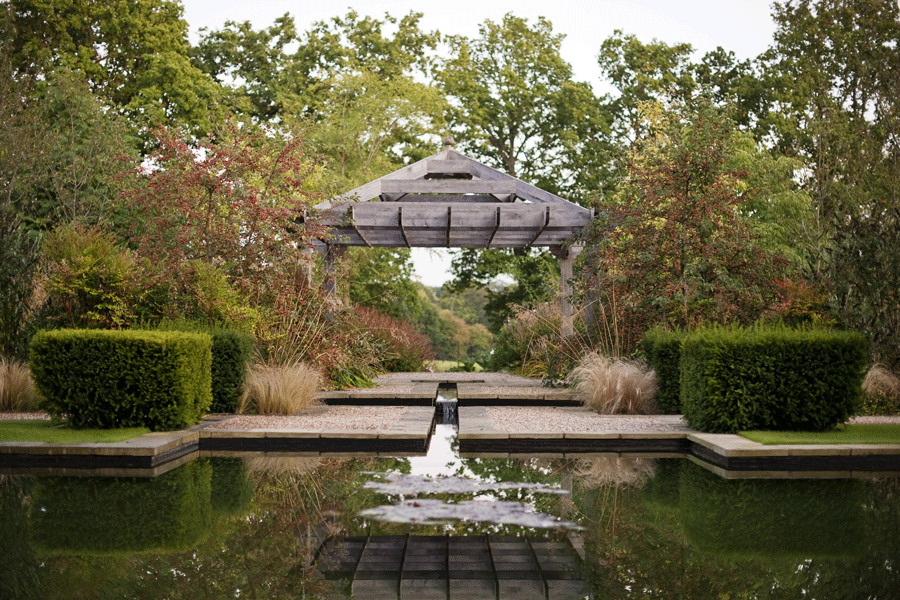Four decades of beautiful visions
This year, the Society of Garden Designers (SGD) celebrates its 40th anniversary and below, we are delighted to share the different tastes and trends ten leading designers and members of the SGD have seen over the past four decades, since the Society was founded.
From Garden Plot to Outdoor Room
A greater understanding of the potential our gardens have to offer has had a profound effect on how garden design has changed over the last 40 years. Designer James Scott MSGD, points out that when he began designing 30 years ago, people viewed their gardens simply as a place to be ‘gardened’: “Over time that has completely changed,” he says. “Gardens are increasingly being seen as an extension to the house and offering the opportunity to be ‘styled’ in the same way you might style a room.”
Juliet Sargeant FSGD feels that the garden has ‘grown up’ and that we have become more sophisticated, now incorporating a wonderful variety of materials, features and plants that weren’t even considered 20 years ago. Andy Sturgeon FSGD, has seen a gradual move towards the contemporary style of garden we know today, echoed by Andrew Wilson FSGD who agrees that we have “developed a new Modernism in style“.
Formal beds to wild meadows
When Cleve West MSGD started designing, grasses were a novelty yet today he cannot imagine not using them. Andrew Wilson adds that the concept of the ornamental meadow and the New Perennial Movement have all conspired to deliver a perennial dominated planting palette replacing the woody shrubs of old.
As Sarah Eberle FSGD points out you can date a garden by the plants that have been used, as they, more than any other aspect of a garden, are followers of fashion. So we moved from the traditional borders of the 1980s and 1990s to the New Perennial Movement of the late 20th century. “When I started out, shrubs were the backbone of everything anyone did. Perennials were a sideshow“, says Andy Sturgeon, who designed his first garden in 1983: “Today wildflower meadows, new perennial planting and grasses have taken centre stage.”
However, there are some plants that have never gone out of fashion such as the English Country Garden style of roses and lavender. Debbie Roberts MSGD points out that the traditional borders of softer flower colours are still popular. In some respects, ‘what goes round comes round’, and Juliet Sargeant for one says she is delighted to see hydrangeas back in fashion after 25 years in the shadows.
Staying local
“With sustainability at the forefront of our minds now, high quality, environmentally-friendly products such as porcelain and composite decking have been game-changing” says Andy Sturgeon. “York stone seemed to be everywhere in the late 90s“, says Andrew Wilson.
Now, the provenance of garden materials is becoming increasingly important with many more people thinking about where materials come from and only using locally sourced materials.
Smaller Gardens, Greater Expectations
 (above: Garden designed by Jo Thompson)
(above: Garden designed by Jo Thompson)
With the average house and garden getting smaller year on year, garden design has obviously had to adapt. Andrew Duff, MSGD (Vice-Chair of the Society of Garden Designers) points out that clients expect a great deal from a small space: “In a large garden you can create journeys, both visual and physical, but this has become more difficult as gardens have become smaller,” he says. James Scott has noticed a trend towards more zoned areas as a way of meeting different needs while Jo Thompson MSGD has developed a multi-functional approach to her designs: “A buttercup-filled meadow is a view, a seat is a piece of art, a rill is a wine cooler, a weeping birch is a shady picnic spot” she says.
From decoration to recreation
If the 50s were about ornamentation then the 80s was the decade that paved the way for the concept of recreation in our outdoor spaces. Robin Templar-Williams FSGD, who began designing gardens in 1986, points out that long gone is the brick-built BBQ, the terracotta urn placed on its side among pebbles dribbling water and the gazebo. Now, we are seeing the rise of the outdoor kitchen, says Sarah Eberle.
 (above: Garden designed by Juliet Sargeant)
(above: Garden designed by Juliet Sargeant)
Outdoor seating is now very important plus features such as fire pits, extending use of our gardens later into the evening. Juliet Sargeant agrees: “The simple garden fire for burning twigs, became a fire pit for sitting around and is now a fireplace, complete with outdoor sofa and stereo system.”
From green spaces to sustainable ecosystems
The Society point out that gardens have not always been as green as they appeared but with a renewed focus on climate change we have moved into the new millennium with more awareness and are now aiming to create sustainable gardens.
“A greater understanding of biodiversity has definitely made people re-evaluate their priorities in recent years, with many more people aware of the issues when it comes to designing their gardens,” says Cleve West.
 (above: Garden designed by Cleve West)
(above: Garden designed by Cleve West)
“We have seen an understandably greater respect for sustainability and environmental issues” agrees Andrew Duff, “with a return to a more natural way of designing demonstrated by the careful choice and appropriate use of plants and planting compositions.” Jo Thompson, whose designs have always had sustainability, climate change and biodiversity at their heart, has noticed a significant change too: “Whilst clients used to sometimes greet these concepts blankly, it is now at the heart of every initial conversation I have.”
From Niche to norm
Our taste in plants and design elements may change over time but we all still want our gardens to be a beautiful place where we can escape. A garden is no longer the preserve of the wealthy and over the past 40 years more and more people have begun to understand the importance of good design and how this ultimately leads to a better garden.
“When I started out people literally didn’t know what a garden designer was” says Andy Sturgeon, who credits Terence Conran and Ikea for teaching people the value of good design. “Now everyone knows what we do and understands the benefits it can bring. Today, the attitude and vision of clients has allowed us to design some amazing gardens that were unimaginable years ago.”
 (above:Garden designed by Acres Wild)
(above:Garden designed by Acres Wild)
As the SGD point out, during the pandemic, the way we have used and viewed our gardens has changed dramatically. There is no doubt that gardens and open spaces are crucial to our mental health and wellbeing and they have been important during this difficult time. Taking time out to look at changing trends and possibilities for our gardens, how important they are to the environment and our wellbeing will always be time well spent.
For more information on the Society of Garden Designers please visit: www.sgd.org.uk
Caption credit: Garden by Robin Templar-Williams FSGD



